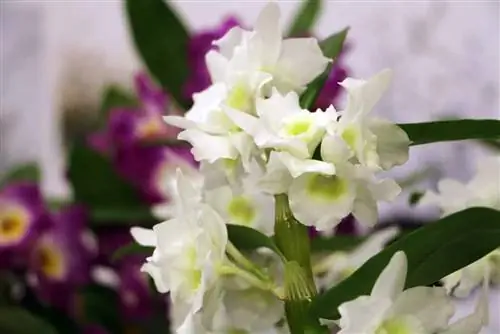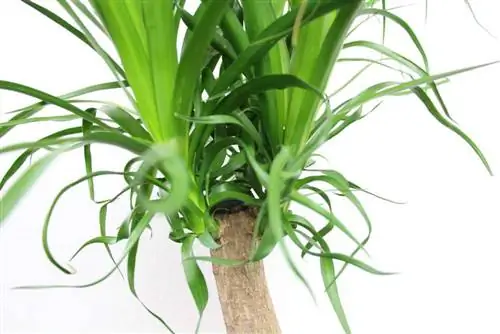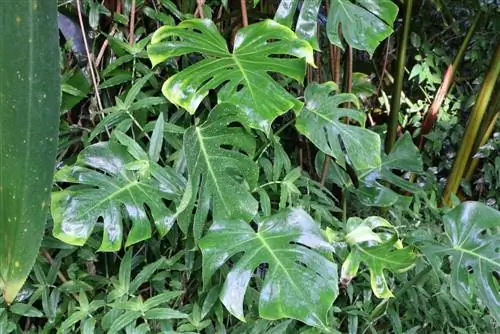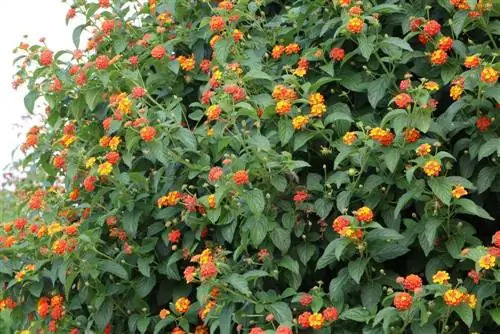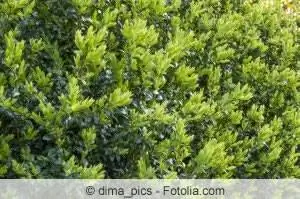- Author admin [email protected].
- Public 2023-12-17 03:39.
- Last modified 2025-01-24 12:45.
Dendrobium orchids are among the popular plants in our homes. In spring, beautiful flower spikes with colorful and beautifully shaped flowers develop on the sprout-like stems, which usually decorate the plant for weeks. That's why orchids like the dendrobium are among the most popular flowering plants in our homes. With a few simple rules, care is easy and the pretty orchid will bloom anew every year. What is particularly important for many species is a resting phase in which the Dendrobium orchid can gather new strength.
Profile
- Botanical name: Dendrobium
- other names: dendrobium, grape orchid
- most species are evergreen
- Flowers: 1-10 centimeters large (single, in spikes or clusters)
- Flowering time: usually in winter/spring
- almost all species grow on trees (epiphytes)
- Growth height: 10-70 centimeters
Species and occurrence
The Dendrobium orchids form one of the largest genera with over 1500 species. They are native to tropical and subtropical areas of Asia and America up to Australia, where they grow primarily as epiphytes (epiphytes) on larger trees. With their so-called aerial roots, they not only hold on to the host plant, but also absorb water and nutrients. During the flowering period, beautiful flower panicles emerge from the upper leaf axils. Some well-known species are:
- Dendrobium abberans (very compact and small, pure white flowers)
- Dendrobium anceps (unusual flower shape)
- Dendrobium antennatum (two upper petals very long and narrow)
- Dendrobium chrysanthum (flower shape and color like chrysanthemums)
- Dendrobium macrophyllum (triangular petals)
- Dendrobium nobile (flower shape reminiscent of pansies)
- Dendrobium Phalaenopsis (one of the most popular species)
- Dendrobium tangerinum (curled petals)
- Dendrobium usitae (many small flowers, clustered on the panicle)
Location
As an epiphyte from the rainforest, Dendrobium prefers a bright location and high humidity. A south-facing window without a protective curtain (or other shade-providing plants) is not exactly the optimal location. East or north windows are better. The orchid copes well with normal room temperatures between 15 and 25 degrees. However, temperatures should never fall below 10 degrees Celsius.
- Light requirements: bright to partially shaded (no midday sun)
- Soil: well-drained orchid substrate
- high humidity
Tip:
The flowering period can be extended by keeping the plant a little cooler as soon as the first buds appear (not below 15 degrees).
Pouring
The higher the humidity where the Dendrobium orchid is located, the less it needs to be watered. At least 60% relative humidity would be optimal. A dendrobium is therefore happy to be sprayed with water occasionally.
- use low-lime water (rainwater) for watering
- water the pot with substrate once a week
- dip into lukewarm water for a few seconds
- drain well
- the substrate must never be too moist (root rot)
- water thoroughly during flowering
- water only sipwise without flowers
Tip:
If you spray the aerial roots with water every other day, you can let the substrate dry out a little without damaging the orchid.
Fertilize
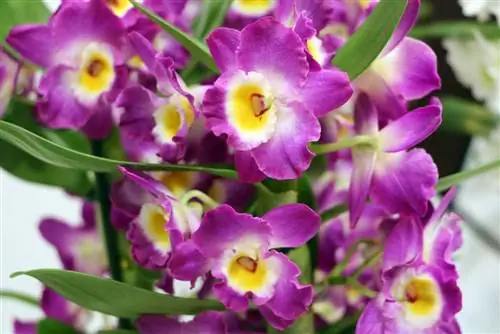
Ideally, a fertilizer is not poured into the substrate, but rather sprayed over the leaves. Special foliar fertilizers tailored to orchids are available commercially. These are mixed with water once a week or less frequently and sprayed over the leaves and aerial roots during the growth phase. Alternatively, commercially available orchid fertilizer can be added to the irrigation water (dipping tank) every four to eight weeks. Fertilize only during the growth phase.
Repotting/substrate
Orchids such as Dendrobium must under no circumstances be planted in normal potting soil. There they would rot within a very short time. If a dendrobium needs to be repotted because its roots have penetrated the substrate well, a special orchid substrate must be used. This can also be easily made yourself:
- Mixture of several components
- Tree bark (pine or pine bark)
- Pieces of wood (from tree cuttings)
- Charcoal pieces
- well dried and pest-free
- If in doubt, dry in the oven at 50% for a few hours
- alternatively place in the microwave for a few minutes
To repot, the Dendrobium orchid is carefully pulled out of its old pot and shaken off as much of the substrate as possible. Special orchid pots are best suited for planting. These are transparent so that you can get a good overview of the condition and number of roots. These pots also have a slightly raised base so that the orchid is better protected from waterlogging. Of course, a dendrobium can also be planted in any normal plastic pot. First, all roots are carefully bent into the new container (they break off quickly) and filled with fresh substrate. To avoid holes, the pot can be placed firmly on the surface several times.
Tip:
If you water with normal, lime-containing tap water, the old substrate should be removed every year and replaced with a new one.
Propagate
Dendrobiums can be propagated by cuttings or by division, as long as a sufficient number of bulbs are reached in older plants.
Offshoot (Kindel)
Some plants form so-called kindles, which are offshoots that the plant produces in order to reproduce. It would be wrong to separate the small young plant from the mother and plant it in a separate pot. The offshoots are usually not sufficiently developed and therefore die quickly.
- spray the child a little with water every day if possible
- occasionally spray with a little fertilizer (rare)
- Leave on the mother plant for several months up to a year
- only separate when there are sufficient roots
- carefully insert into fine orchid substrate
- the roots are very fragile
- Keep humidity high initially
- insert in indoor greenhouse or plastic bag
- ventilate daily
Tip:
Some species form a lot of children when their roots are too wet and begin to rot - as a last chance for survival. So always take a look at the roots.
Share
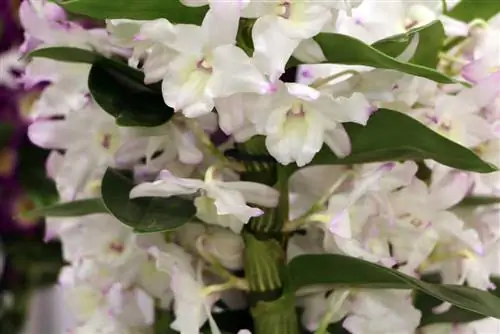
If more than eight bulbs and at least two new shoots have formed on older plants, the dendrobium can be divided. For really large orchids, this method also rejuvenates plants that have become lazy to bloom. It is divided at a time when the orchid will be repotted anyway.
- Pull the plant out of the pot and shake off as much soil as possible
- Carefully pull the roots apart
- Cut the rhizome (connection between the bulbs) with a sharp knife
- pay attention to cleanliness (sterile knife, scissors)
- at least 4-5 bulbs must be left per plant
- Replant both (or more) parts separately
- After division, some dendrobiums may have longer flowering breaks
Head cuttings
In rare cases, root formation can be observed in the upper third of the plant in some Dendrobium species. Their growth can be increased by adding moss and spraying frequently. If the roots are well developed (after a few months), the top cutting is cut from the mother plant and potted in its own planter.
Wintering
Most dendrobiums thank you for a more or less extended winter rest with lush flowers the following year. For most species, lowering the temperature to 15 degrees is sufficient. Some varieties prefer to be kept at around 10 degrees permanently. The cooler the orchid is, the less water it needs. The overwintering place should definitely be bright, because most grape orchids keep their leaves even during this time.
- fertilize once a month during warm winters
- If the winter is cool, the plant does not need any fertilizer
- Watering regularly (once a month)
- protect from drafts
- Temperatures must not fall below 10-12 degrees!
- Exception: Dendrobium nobile (above 5 degrees)
Diseases and pests
With good location and care conditions, orchids like the dendrobium rarely get sick. However, if the humidity drops when the heating is in operation, sucking pests such as scale insects sometimes appear. Rotting roots can often be seen if the orchid is too wet. Then the old soil and rotten roots must urgently be removed and the dendrobium must be planted in fresh substrate.
Conclusion
Orchids from the genus Dendrobium are among the most popular orchid species in our homes. A wide variety of hybrids with colorful or bizarre flower shapes are available commercially. Dendrobiums do not place very high demands on a hobby gardener and reward a little attention and care (almost) all year round with magnificent flower spikes.

